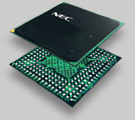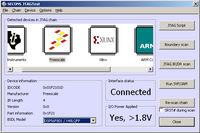What is a Ball Grid Array?
 The Ball Grid Array or BGA, is a very different package to those using pins, such as the quad flat pack. The pins of the BGA package are arranged in a grid pattern and this gives rise to the name. In addition to this, rather than having the more traditional wire pins for the connections, pads with balls of solder are used instead. On the printed circuit board, PCB, onto which the BGA components are to be fitted there is a matching set of copper pads to provide the required connectivity.
The Ball Grid Array or BGA, is a very different package to those using pins, such as the quad flat pack. The pins of the BGA package are arranged in a grid pattern and this gives rise to the name. In addition to this, rather than having the more traditional wire pins for the connections, pads with balls of solder are used instead. On the printed circuit board, PCB, onto which the BGA components are to be fitted there is a matching set of copper pads to provide the required connectivity.
BGA (Ball Grid Array) inspection using JTAG
Disadvantage of BGAs is that, once the package is soldered down, it is very difficult to look for soldering faults. X-ray machines and special microscopes have been developed to overcome this problem, but are expensive. If a BGA is found to be badly soldered, it can be removed in a rework station, which is a jig fitted with infrared lamp (or hot air), a thermocouple and a vacuum device for lifting the package. The BGA can be replaced with a new one, or can be refurbished or reballed. Packets of tiny ready-made solder balls are sold for this purpose.
BGA inspection is one area of the manufacturing process that has raised a considerable amount of interest since the introduction of the first BGA components. BGA inspection cannot be achieved in the normal way using straightforward optical techniques because, quite obviously, the solder joints are underneath the BGA components and they are not visible. This creates problems for BGA inspection. It also created a considerable degree of unease about the technology when it was first introduced and many manufacturers undertook tests to ensure that they were able to solder the BGA components satisfactorily. The main problem with soldering BGA components is that sufficient heat must be applied to ensure that all the balls in the grid melt sufficiently for every BGA solder joint to be satisfactorily made.
Due to cost of X-ray BGA inspection, electrical testing is very often used. Very common is boundary scan testing using IEEE 1149.1 JTAG port.

 Click here to check prices and order now!
Click here to check prices and order now! Didn't find what you were looking for? Fill in the contact form and we will get back to you as soon as we can.
Didn't find what you were looking for? Fill in the contact form and we will get back to you as soon as we can.